In June 1772, Jean-Benjamin de Laborde published a prospectus announcing ‘an absolutely new kind’ of publication of what he called chansons pittoresques [picturesque songs]. While there seemed to be new collections of songs published all the time, he wrote, Laborde’s Choix de Chansons would differ by presenting a combination of image, music, and text. This prospectus provides a valuable insight into the production of Laborde’s songbook project, and from it we learn about many of the publication’s peculiarities.
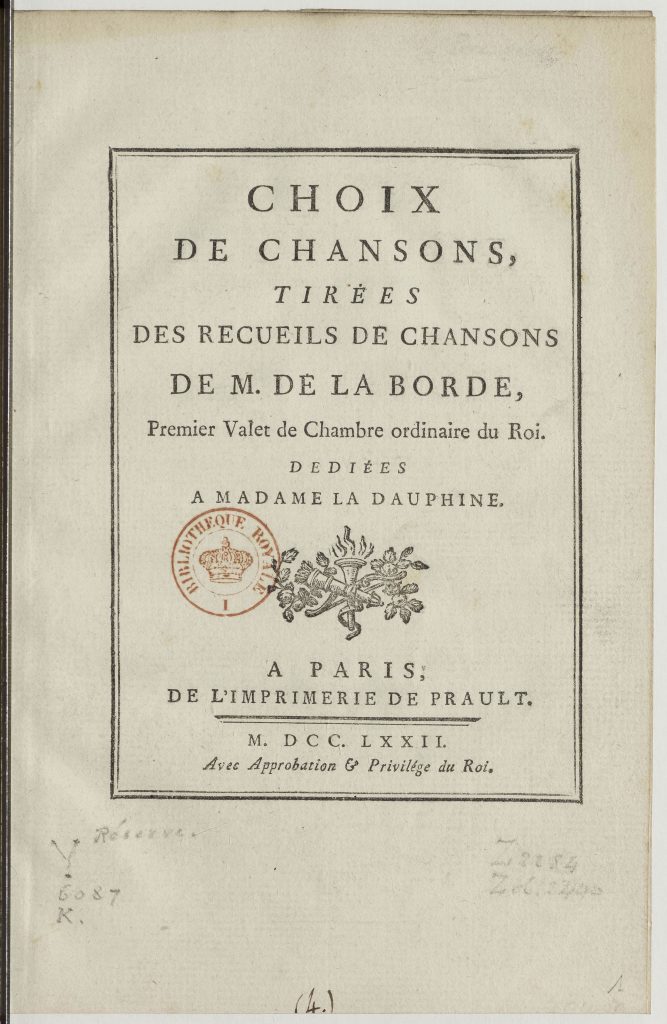
Laborde was in a precarious situation in 1772. His cousin and supporter the Marquise de Pompadour (Louis XV’s long term maîtress-en-titre and close friend) had died from tuberculosis in 1684. She had helped him to gain the position of premier valet du chambre to the king, an office that guaranteed close access to the Court. Laborde was a decadent bon viveur. He was not yet married, but he had fathered a daughter to the famous ballerina and courtesan Marie-Madeleine Guimard. His debts were mounting to a vast sum, near 500,000 livres when Louis XV died in 1774, as he was equally responsible for the gambling debts of his erstwhile mistress.1 The king made several promises to rectify Laborde’s terrible finances, none of which were fully honoured.
The heirs apparent to the French Crown were very different to their grandfather. Marie-Antoinette married her first cousin, Louis-Auguste, at 14. She was the daughter of the powerful Austrian Empress, Maria Teresa (1717-1780) and had spent an idyllic childhood in the palaces of Hofburg and Schönbrun. She was pretty, elegant, and musical and timid. She had learned to play the harp, harpsichord, and flute under the instruction of Christoph Willibald Gluck (1714-87). The dauphine, as she was styled before Louis XV’s death, and her young husband were both naïve and prudish. Quite the opposite of their grandfather, whose prodigious appetites for beautiful women earned him the moniker Louis le Bien-Aimé (the well-loved). The dauphine was shocked by the louche climate of the French Court. The king’s latest favourite, Madame du Barry, was hated by aristocratic snobs like the dauphine who thought her beneath them but had to pay du Barry due deference as the king’s mistress.
Laborde was in trouble. As Pompadour’s cousin, and the man who helped du Barry to attain her place at Court, his reputation was sullied in the eyes of the young royals. The king had made many generous offers that would clear Laborde’s debts, but none of them had come to fruition. He was one disaster away from absolute ruin. If the king of France died, he might easily go bankrupt.
This is the climate of mid-1772 when Laborde published the prospectus offering a subscription for a luxurious publication. Choix de Chansons may well have been “dedicated to Madame La Dauphine” to get into the young princess’s good graces. Louis XV was still alive and would have supported his friend Laborde in that endeavour. The prospectus was published by the royal printer Laurent-François Prault (1712-80) who had taken over the Imprimerie de Prault after the death of his father Pierre in 1768. And surely it is no coincidence that Laborde advertised that the musical scores had been written for the harp, Marie-Antoinette’s favourite instrument.
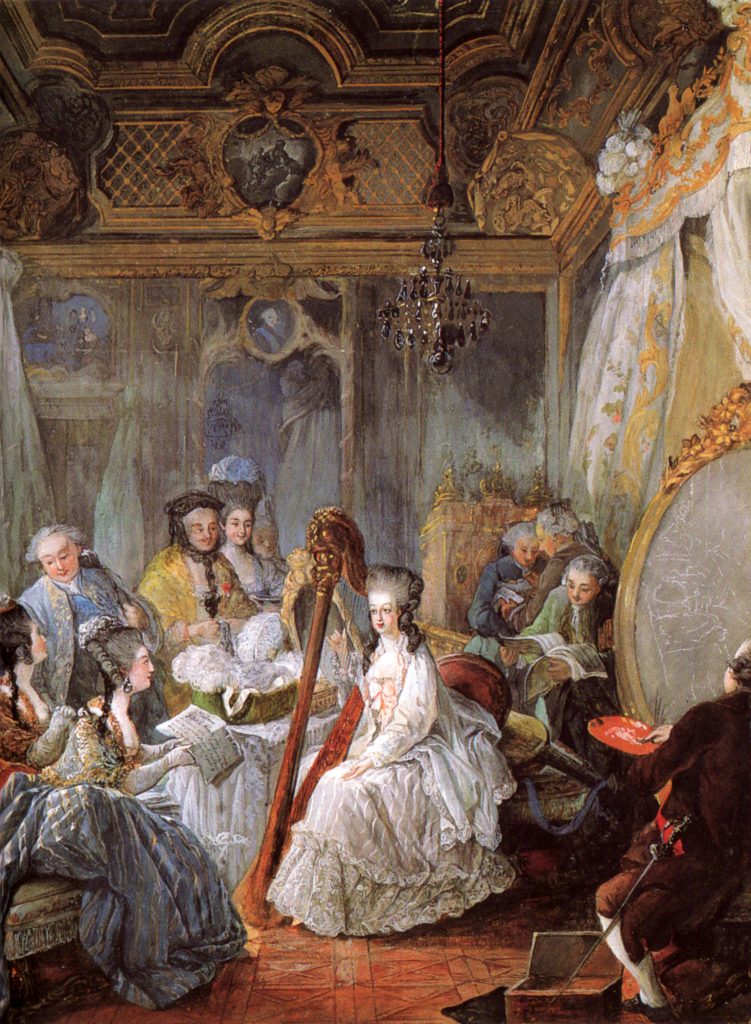
Choix de Chansons was a money-making scheme too. The very first lines of the prospectus suggest that published collections of songs were a burgeoning market—perhaps even a very profitable one—and he hoped that his contribution would be the finest of them all. The unique selling point was the “triple advantage of amusing the mind, by gay and interesting verses, of flattering the ear with an easy & agreeable song; and finally, to attracting the eyes by pictures rendered with all perfection…”

Laborde had excellent connections to the Paris art world. His cousin, the Marquis de Marigny, was the surintendent des bâtiments du roi, in charge of the decoration of royal palaces; his mistress, La Guimard, held one of the most fashionable salons of the age, frequented by artists and intellectuals; he was a friend of Voltaire, and wrote the score to the philosophe’s opera Pandore; he had known premier peintre du roi, François Boucher (1703-1770) as they were both members of a masonic society called le Caveau where many of the songs Laborde published in Choix de Chansons may have debuted.2 Laborde was in an excellent position to convince Boucher’s collaborator and the leading peintre-graveur (artist-engraver) Jean Michel Moreau (called Moreau le Jeune) (1741-1814) to design and engrave the illustrations for this luxury edition.
The prospectus tells us that the initial plan was to produce two small volumes in octavo (approximately 22 x 15 cm), and each would contain 25 songs accompanied by a fine engraving—half the scope of the final publication which ran to four volumes with 100 song sets in total. To ensure that none of the “very beautiful paper” on which the books were to be printed was wasted, and “to leave as few useless pages as possible” verses for another song would be added if there was room on the page. The second song would not be illustrated, however. Aside from the promises of fine quality, the main innovation of Choix de Chansons was the inclusion of an engraving of a ‘painterly subject’ for each of the songs. This is what made Choix de Chansons an ‘absolutely new’ proposition on the market.
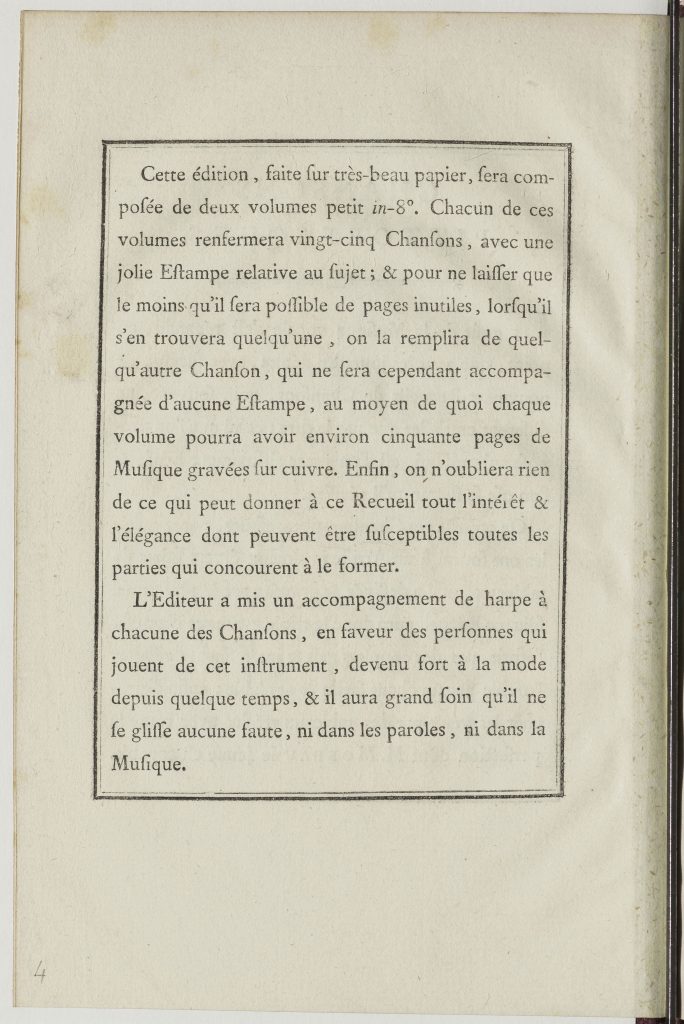
Laborde took advantage of his connections to the Académie Royale de Musique (known as the Opéra), and enlisted Pierre-Nicolas De Lormel, “Printer to the Royal Academy of Music” on rue du Foin St Jacques to handle not only the publication, but to collect money from subscribers. Like many eighteenth-century publishers, Laborde hoped to cover the costs of production by obtaining payment in advance. That was the purpose of this document, to whet the appetite of music lovers and bibliophiles who could pay 24 livres (50 percent of the two-volume publication) in advance. Delivery of the first volume was promised for January 1, 1773, at which time subscribers would pay another 24 livres in advance of the second volume due to come out on July 1 the same year. Subscribers had the advantage of paying 50 percent less than those who bought Choix de Chansons after publication. They would also have their names listed in the publication, advertising their largesse in support of the arts. Laborde must have been hoping that his wealthy friends would support the project. As an extra incentive, subscribers were encouraged to order multiple editions. Anyone who ordered twelve copies would receive the thirteenth for free.
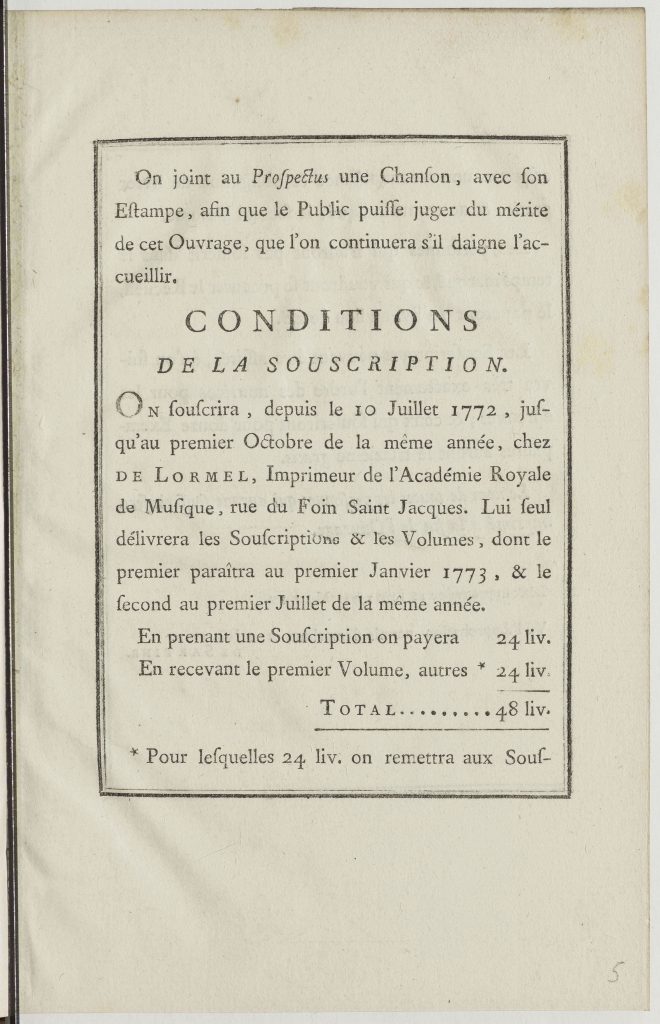
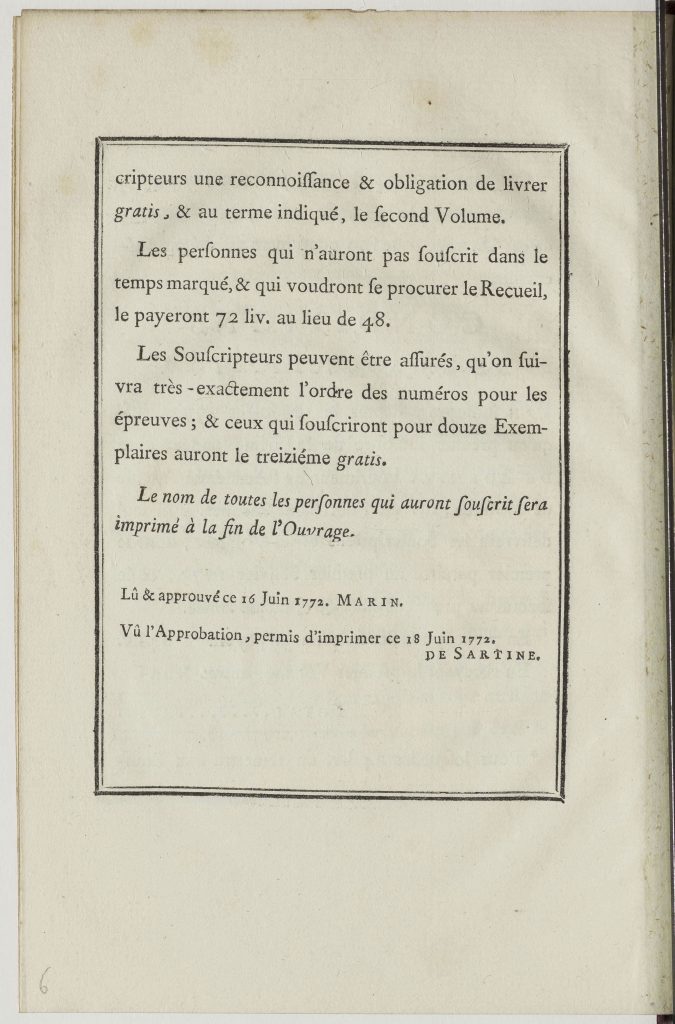
But that was not the only incentive offered in the prospectus. The sample set of title page, illustration, musical score, and lyrics that followed the advertisement was offered as “so that the Public can judge the merit of this Work.” The sample “Les Amours de Glicere et d’Alexis, romance,” corresponds to second song set (S.1.02) published in the first volume of Choix de Chansons. It is a fashionable pastoral subject found in plays, poems, operas, and paintings of mid-eighteenth-century France.
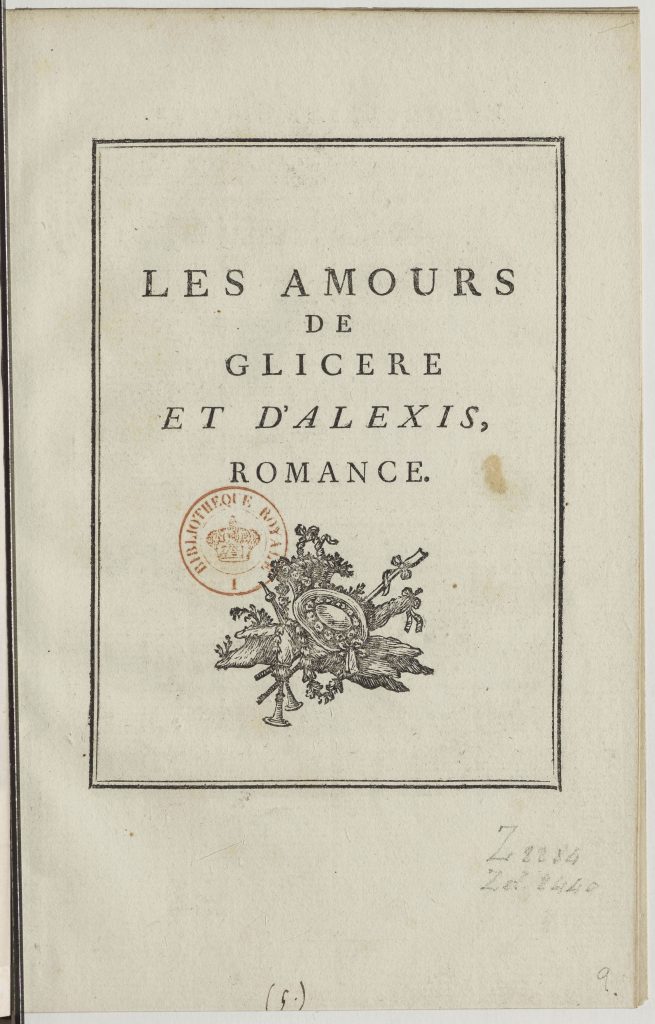
The song tells the story of the youthful Alexis, who had loved the pretty shepherdess Glicere from afar for two years. One day, when he sees Glicere’s mother working in the field, he runs to her door and declares his undying affection. Glicere receives Alexis’ advances with humility and moral reticence: “you can’t come in… we can be overheard.” Alexis makes Glicere promise to meet him in the next morning when she takes her sheep to the meadow. It’s a moral tale that, predictably, ends with badly for the young shepherdess:
[The next morning the shepherdess / wanted to honour her vow / but it is claimed that the poor thing/ lost much in acquitting herself.] That is the moment that Moreau le Jeune captures in his engraving.“Le lendemain la Bergerette / Voulut accomplir son serment; / Mais on prétend que la pauvrette / Perdit beaucoup en s’acquittant.”
Glicere fulfils her vow at the price of her virtue.
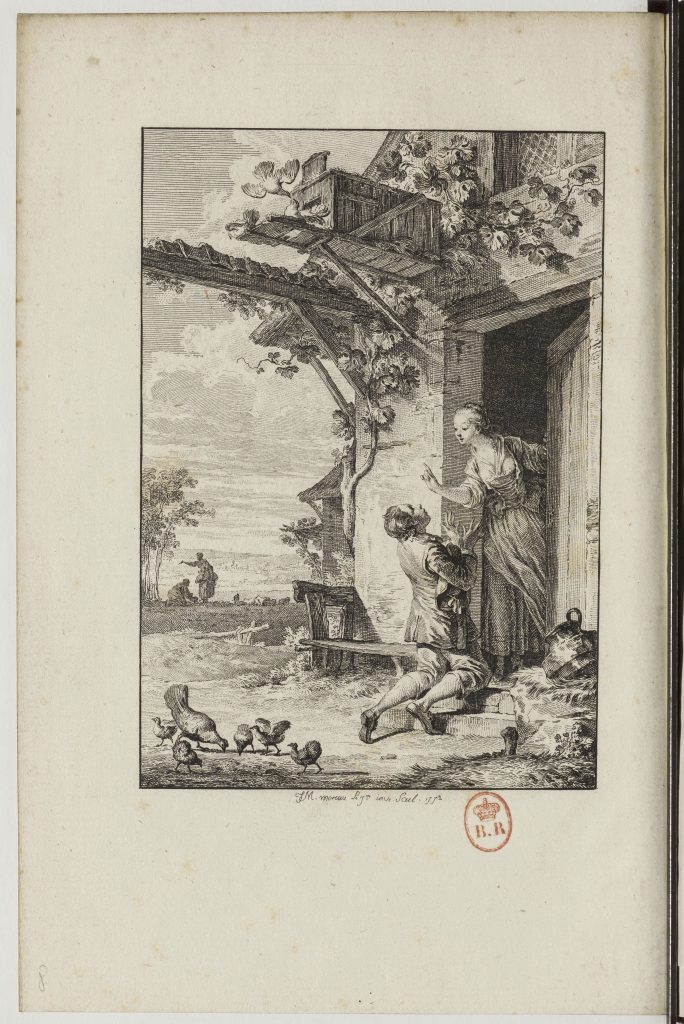
For his illustration, Moreau le Jeune chose to capture the moment of Alexis’ declaration of love, rather than Glicere’s fall. Alexis kneels precariously on the steps before Glicere, his hat under his arm in a show of gallantry, the frisson of his sentiment animating his hair and fingers. The shepherdess leans out of the doorway raising a finger to quiet him. In the background the is shadowed figure of Glicere’s mother working in the fields. In the foreground, appears a mother hen and her chicks. Above them two doves appear to kiss before the dovecote. These avian metaphors are rather heavy handed. The hen and her brood remind us of Glicere’s mother behind them, hinting at maternal care, while simultaneously suggesting that children might result from amorous liaisons. Doves symbolise romantic affection—the idiom ‘to bill and coo’ derives from their behaviour. Moreau has shown one dove flying to meet its mate, beak-to-beak, while a another sits close to the edge beating its wings in preparation to fly the nest. Just like the young Gliciere, the fledgling dove is not quite ready for independence.
Typical of the pastorals and genre scenes painted by François Boucher and Jean-Baptiste Greuze from the 1740s on, Moreau draws upon well-established tropes inspired by popular theatre of the day. Pictures of pastoral fantasies peopled by well-dressed peasants in their fashionable silks, linens, and culottes are more like the aristocrats who would dress up to stage entertainments for one another to stave off ever-present ennui. Moreau’s treatment of the subject somewhere between that of Boucher than Greuze. Where Boucher’s shepherds and shepherdesses were captured in moments of romantic affection, Greuze often depicted the sorry aftermath. Where Boucher painted rosy-cheeked lovers, Greuze would show a sobbing maid.

Prospectus version (1772)
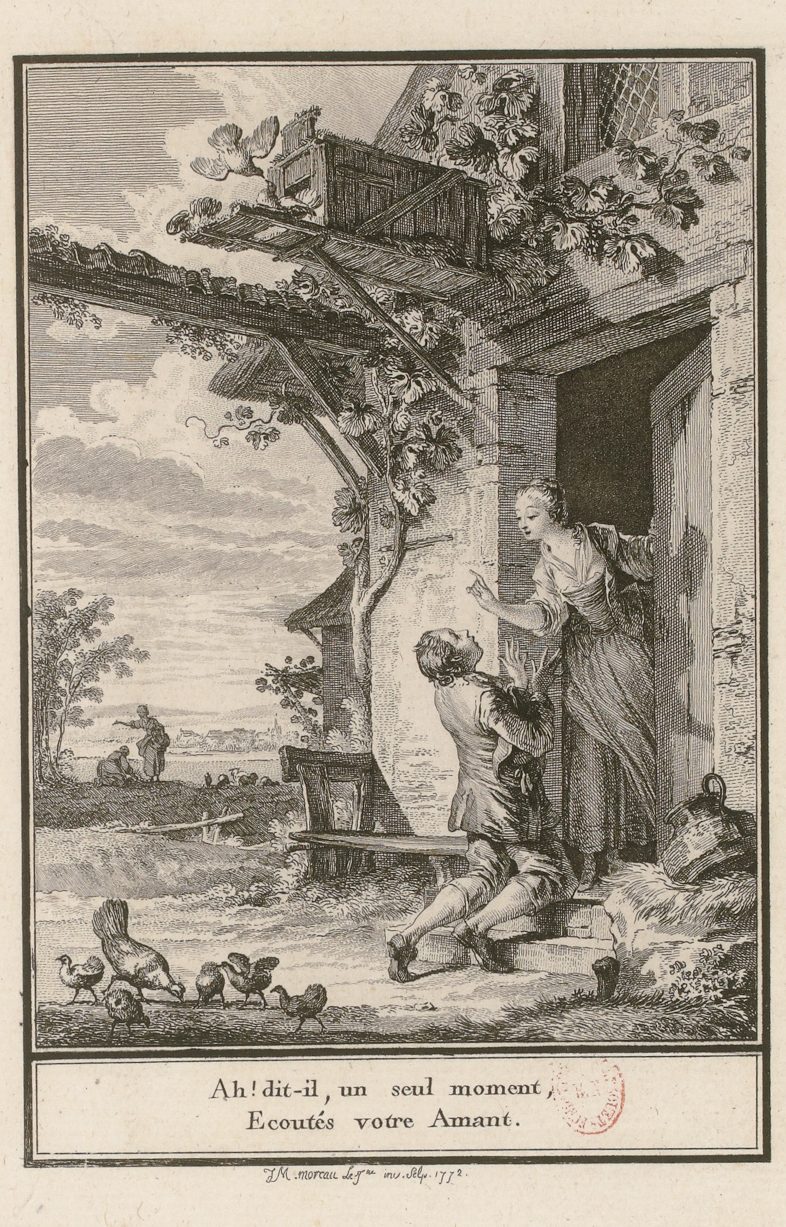
The sample engravings in the prospectus differ to those of the final publication. Placing Moreau’s two etchings side-by-side reveals their subtle differences. Glicere’s body casts a shadow on the doorframe in the final publication; the stone wall next to that shadow is more rusticated; and the detail of vine leaves next to the upper window differs too. This does not reflect substantial revision, however. Both versions of the print demonstrate Moreau’s mastery of the burin. The title page is also different. The simple font of the prospectus version is exchanged for a more elaborate form. The final word, ‘romance’, indicating the sentimental mode of the song, has been elided from the 1773 publication.3 The music engraving differs too, and notably the intonation of the words ‘depuis’ and ‘Glicere’ of the first line are more attenuated in the final version.
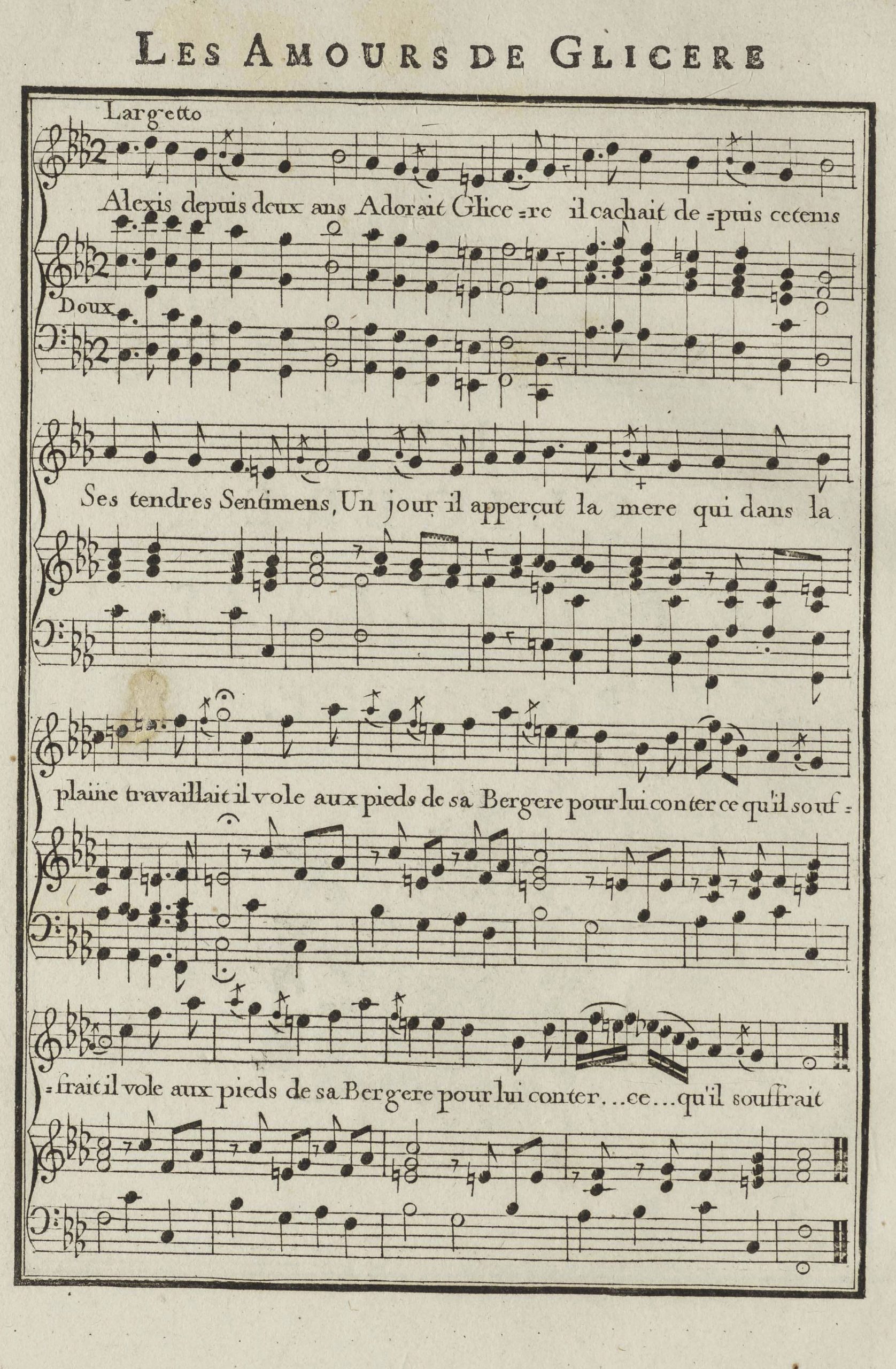
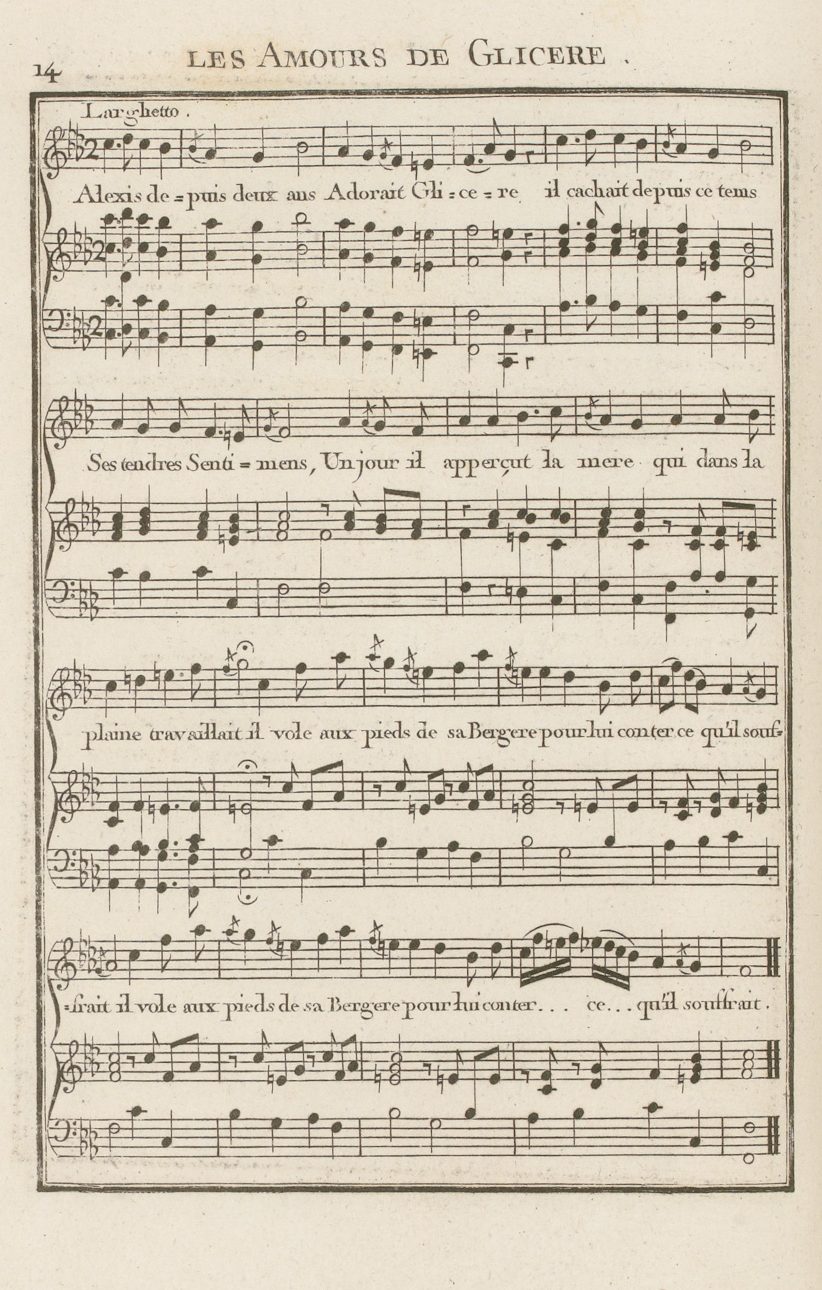
An extra song has been added to fill the fifth page of the song set in the final publication. That is the standard format. The illustration comes first, printed on one side of the sheet of paper (1). Next is the title page, verso (2), with the score on the reverse (3). The next sheet either continues the score for non-strophic songs (songs for which the music differs for each verse), or it contains the lyrics for the subsequent verses of the song set out as poems (4). If the main song finishes on page 3 or 4, as it does in the case of Les Amours de Glicere et d’Alexis, another song is added to ensure that all five pages are filled. This is what Laborde had planned, as he noted in the prospectus: “to leave as few useless pages as possible, there will be another Song, which will not, however, be accompanied by a Print…”
The publication of the prospectus for Choix de Chansons led to a remarkable afterlife for the story of Glicere and Alexis. Laborde’s poem was later reset to new music composed by the philosopher Jean-Jacques Rousseau. We know that it was taken from Laborde’s prospectus because the words “paroles tirées d’un prospectus de M. de la Borde.” [words taken from a prospectus by M. de la Borde] appear at the top of Rousseau’s score.4 A radical enlightenment thinker, Rousseau proposed that humankind had an innate moral sense that had been corrupted by religion and society. It led him to argue for a return to nature; a dictum that was, ironically, taken up with great gusto by the aristos who loved to play at pastoral life, epitomised by the fantasy Hameau created for Marie-Antoinette in the gardens of the Petit Trianon. Rousseau was a polymath: a philosopher, writer, and composer, and he returned to that theme continually across his work. The romantic tale of Glicere and Alexis appealed to Rousseau’s fascination for topic of natural urges, love, and morality. It appeared in a collection of songs composed by him titled Les consolations des miseres de ma vie, ou recueil de romances [Consolations of my life’s miseries, or collection of romances.]5
Curiously, the names of subscribers do not appear in the publication of Choix de Chansons as Laborde had promised they would in his prospectus. We can only speculate the reasons for that. The project did little to alleviate Laborde’s precarious financial situation. He was still borrowing large sums of money from his friends in October 1772, four months after the subscription was published.6 Moreau produced eleven engravings in 1772, seven in 1773, and a final seven in 1774. Those are the twenty-five engravings that complete the first volume of Choix de Chansons. The project took longer to complete than anticipated, and subscribers would have to wait at least eighteen months more than expected to see first volume completed.
We do not know why Moreau only completed 25 illustrations, when 50 were commissioned from him. Did he work too slowly? Was the financially troubled Laborde unable to pay him? We may never be sure. But if financial difficulty was the reason that Moreau left the project, it is all the more surprising that Laborde chose to double-down and expand Choix de Chansons to four volumes with 100 songs in total.
It could be that Moreau, being the most sought-after engraver of the day, was slow to produce the fifty prints that Laborde had commissioned. Given his financial troubles, Laborde may have been slow to pay, and that would have done nothing to motivate Moreau to work faster. Perhaps when Laborde realised that he had over-promised his subscribers he decided to expand the publication to provide a cover story for the delay, and to then engage a team of artists and engravers to complete the work. Moreau continued to work on his engravings for the first volume until 1774, despite the title page giving the date of publication as 1773. The engravings in volumes two, three, and four designed by Le Bouteux, Lebarbier, and Saint-Quentin, and engraved by Masquelier, and Née are not dated. An article by Jean-François de la Harpe (1739–1803) in the Mercure de France that the fourth and final volume was published at the end of 1775.7 It seems likely, then, that those other artists were engaged at some point in 1774 and worked until 1775 to finish the publication.
Robert Wellington, 2022.
Transcription and translation of the prospectus:
Chansons Pittoresques.
Le gout de la Musique vocale s’est répandu, au point, que tous les jours on débrite, avec succès, de nouveaux Recueils de Chansons, qui, souvent, ne diffèrent entr’elles que par le titre : celui que l’on propose aujourd’hui, est d’un genre absolument neuf, & l’on ose se flatter qu’il réussira.
On appelle ces Chansons pittoresques, parce qu’elles ont fourni à un Artiste ingénieux divers sujets de tableaux, qu’il a dessinés & gravés avec le plus grand soin : ce Recueil aura donc le triple avantage d’amuser l’esprit, par des couplets gais & intéressans, de flatter l’oreille par un chant facile & agéable ; enfin d’attacher les yeux par des tableaux rendus avec toute la perfection dont M. MOREAU le jeune est capable.
Cette edition, faite sur très-beau papier, sera composée de deux volumes petit in-8o . Chacun de ces volumes renfermera vingt-cinq Chansons, avec une jolie Estampe relative au sujet ; & pour ne laisser que le moins qu’il sera possible de pages inutiles, lorsqu’il qu’autre Chanson, qui ne sera cependant accompagnée d’aucune Estampe, au moyen de quoi chaque volume pourra avoir environ cinquante pages de Musique gravées sur cuivre. Enfin, on n’oubliera rien de ce qui peut donner à ce Recueil tout l’intérêt & l’élégance dont peuvent être susceptibles toutes les parties qui concourent à le former.
L’Editeur a mis un accompagnement de harpe à chacune des Chansons, en faveur des personnes qui jouent de cet instrument, devenu fort à la mode depuis quelque temps, & il aura grand soin qu’il ne se glisse aucune faute, ni dans les paroles, ni dans la Musique.
On joint au Prospectus une Chanson, avec son Estampe, afin que le Public puisse juger du mérite de cet Ouvrage, que l’on continuera s’il daigne l’accueillir.
CONDITIONS
DE LA SOUSCRIPTION.
On souscrira, depuis le 10 Juillet 1772, jusqu’au premier Octobre de la même année, chez DE LORMEL, Imprimeur de l’Académie Royale de Musique, rue du Foin Saint Jacques. Lui seul délivera les Souscriptions & les Volumes, don’t le premier paraîtra au premier Janvier 1773, & le second au premier Juillet de la même année.
En prenant une Souscription on payera 24 liv.
En recevant le premier Volume, autres * 24 liv.
Total………………..48 liv.
* Pour lesquelles 24 liv. On remettra aux Souscripteurs une reconnaissance & obligation de livrer gratis, & au terme indiqué, le second Volume.
Les personnes qui n’auront pas souscrit dans le temps marqué, & qui voudront se procurer le Recueil, le payeront 72 liv. au lieu de 48.
Les Souscripteurs peuvent être assures, qu’on suivra très-exactement l’ordre des numéros pour les épreuves ; & ceux qui souscriront pour douze Exemplaires auront le treizième gratis.
Le nom de toutes les personnes qui auront souscrit sera imprimé à la fin de l’Ouvrage.
Lû & approuvé ce 16 Juin 1772. MARIN.
Vû l’Approbation, permis d’imprimer ce 18 Juin 1772. DE SARTINE
Picturesque songs.
The taste for vocal music has spread, to the point, that all the time Collections of Songs are successfully released, which often differ only in title: the one we propose today, is of an absolutely new kind, and we dare to flatter ourselves that it will succeed.
We call these Picturesque Songs, because they have been given various painterly subjects by an ingenious Artist, which he has drawn & engraved with the greatest care: this Collection will have the triple advantage of amusing the mind, by gay and interesting verses, of flattering the ear with an easy & ageable song; and finally to attracting the eyes by pictures rendered with all perfection which M. MOREAU le Jeune is capable.
This edition, made on very beautiful paper, will be composed of two small volumes in-8o. Each of these volumes will contain twenty-five Songs, with a pretty Print relating to the subject; & to leave as few useless pages as possible, there will be another Song, which will not, however, be accompanied by a Print, by means of which each volume may have about fifty pages of Music engraved on copper. Finally, nothing will be forgotten that may give this Collection every interest & elegance to all the parts from which it is formed.
The Publisher has put a harp accompaniment to each of the Songs, in favor of the people who play this instrument, which has been very fashionable for some time, & he will take great care that there is no error, neither in the lyrics, nor in the Music.
A Song is attached to the Prospectus, with its Print, so that the Public can judge the merit of this Work, which will be continued if they deign to welcome it.
CONDITIONS
OF THE SUBSCRIPTION.
Subscriptions will be taken from July 10, 1772, until the first of October of the same year, at the office of DE LORMEL, Printer of the Royal Academy of Music, rue du Foin Saint Jacques. He alone will honor the Subscriptions & Volumes, of which the first will appear on the first January 1773, & the second on the first July of the same year.
By taking a Subscription one will pay 24 liv.
On receiving the first Volume, another * 24 liv.
Total………………..48 lives.
* For that 24 liv. Subscribers will be given a recognition & obligation to deliver free of charge, & at the term indicated, the second Volume.
People who have not subscribed in the time indicated, & who want to obtain the Collection, will pay 72 liv. instead of 48.
Subscribers can be assured that the order of the numbers for the proofs will be followed very exactly; & those who subscribe for twelve copies will have the thirteenth free.
The names of all persons who have subscribed will be printed at the end of the Book.
Read & approved this June 16, 1772. SAILOR.
Viewed the approval, sanctioned to print this June 18, 1772. DE SARTINE
Notes
1. Couty, 132.
2. On le Caveau see Couty, 51 ff.
3. See Erin Helyard, “Music and Music-making in Laborde’s Chansons pittoresques,” Choix de Chansons: a digital critical edition: https://choixdechansons.cdhr.anu.edu.au/music-and-music-making-in-labordes-chansons-pittoresques/
4. Ibid., 15.
5. Jean-Jacques Rousseau, Recueil des oeuvres de musique de J. J. Rousseau (Paris, 1793). 15-18.
6. Couty, 124.
7. Jean-François de la harpe, Mercure de France (oct, 1775), 13-14.





